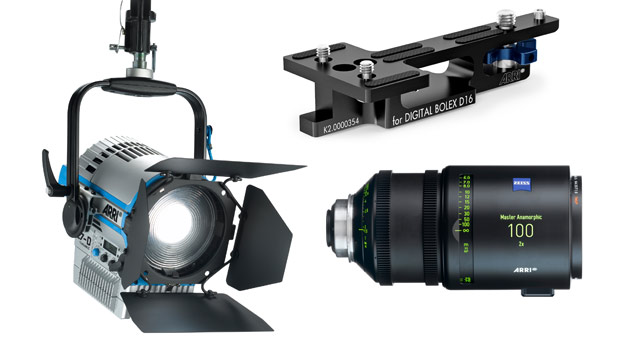New Lighting, Lenses, and Camera Accessories
When news broke about ARRI's scaled down Alexa sibling, the documentary-ready Amira, it was one of the biggest stories out of IBC. But ARRI had a lot more news at the show, including announcements of new accessories for non-ARRI camera systems, some new lighting products, word on lenses, and a prototype time-of-flight camera that may make live-action images more malleable than ever. Here's a rundown of the rest of ARRI's news from IBC.
Lighting
ARRI debuted a new LED Fresnel at the show, the L7-DT, a tuneable daylight counterpart to the L7-TT tuneable tungsten light introduced at NAB. Adjustable from 5,000 to 6,500 K, the new lamp is the same size and weight as the rest of the L7 line but is about 30 percent brighter than the L7-C. Extending the M-Series of HMI lamps, ARRI showed the 800W M8 fixture, which the company said approaches the light output of a 1,200W Fresnel or PAR. ARRI also said it was merging Arnold & Richter Cine Technik and ARRI Lighting Solutions under the ARRI banner with General Manager Sigrid Müller.
Pro Camera Accessories
ARRI showed new accessories for the Blackmagic Pocket Camera (BMPC), Digital Bolex, Sony F5/F55, and Canon EOS C100/C300/C500. The BMPC now has an adapter plate to fit ARRI's MBP-3 mini baseplate, and the CHS-4 support fitting prevents the camera body from flexing when using large lenses. The Digital Bolex also gets an adapter plate for MBP-3 compatibility, allowing heavier PL-mount lenses to be used with a lens adapter. The ARRI broadcast plate for Sony's F5 and F55 is designed for documentary-style production on quick-release tripod adapters and supports a 15mm LWS console at the back of the camera. A new start/stop cable is also available. The Canon cameras are supported with the CHS-3 support fitting, again allowing the use of longer lenses or a top handle. Also new is a redesigned 300mm bottom plate, as well as new 450mm and 600m versions, the BPS-2 bride plate sled for lighter camera rigs using the MBP-3 and other ARRI botom plates, and new UBS-2 and LBS-2 bridge supports with hard-mounted rosettes.
Lenses
ARRI introduced what it calls the first super-wide-angle zoom for the pro cine market, the UWZ 9.5-18/T2.9 lens, with a 33.7mm image circle. The company said its performance compares well with high-end wide-angle prime lenses, suggesting it could replace them on set. Distortion on the new lens is said to be less than 1% at 9.5mm and less than 0.1% at 18mm. No word on when that glass will be available, but ARRI did lay out the full calendar for release of the highly anticipated new ARRI/Zeiss Master Anamorphic series, marketed as The Magnificent Seven. The MA35, 50, and 75 began shipping last month, and the MA100 is slated to ship in October. Look for the MA40 and 60 in February 2014, with the MA135 to follow in April.
Also new in and around ARRI lenses is the SXU-1 single-axis wireless controller. It works with the Alexa Plus and Studio cameras, as well as with ARRI's UMC-3A universal controller. It can be used in conjunction with — or in lieu of — ARRI's three-axis WCU-4 controller. It's powered by a camcorder battery, which an AC option.
RGB+Z Motion Scene Camera
Finally, ARRI brought a science project to the show. The Alexa Scene prototype camera is a combination of an Alexa Studio and a time-of-flight camera — so called because it calculates depth information for objects captured in an image by measuring the time it takes light to travel from a special sensor to each point in the scene. (Both sensors would view the scene through the same aperture.) The synchronized Z-axis data, ARRI said, will permit video images ot be manipulated in much the same way as computer-generated imagery. Roto'ing objects out of the frame for VFX or 3D conversion purposes would presumably become an entirely trivial automated process.
"Compositing, color-grading, keying, and many more post-production tasks can be facilitated by our new camera," said ARRI Principal Research & Development Engineer Johannes Steurer in a prepared statement. "It provides cutting-edge, high-resolution RGB images with fully synchronized depth maps, where both are taken through the same lens and hence feature a parallax-free 3D image of the scene."
Camera research for the SCENE project was co-funded by the European Commission's Seventh Framework Programme, ARRI said. In addition to ARRI, partners in the research program include Barcelona Media and Brainstorm Multimedia in Spain, Technicolor (DTO) in Germany, 3DLIZED in France, the Fraunhofer Heinrich Hertz Institute in Germany, the Interdisciplinary Institute for Broadband Technology in Belgium, Saarland University in Germany, and the University of Surrey in the U.K.
Crafts: Shooting
Sections: Technology
Topics: ARRI bmpc c100 c300 C500 digital bolex f5 f55 ibc 2013 l7
Did you enjoy this article? Sign up to receive the StudioDaily Fix eletter containing the latest stories, including news, videos, interviews, reviews and more.










While the z data will help speed up stereo conversion work it will definitely not make the process “trivial”. You will still require hundreds of people doing Roto/paint in Asia to get a conversion not resembling clash of the titans. There is still a huge amount of work fixing stretching from occlusions and normal buzzing and noise you will get from the depth map edges.